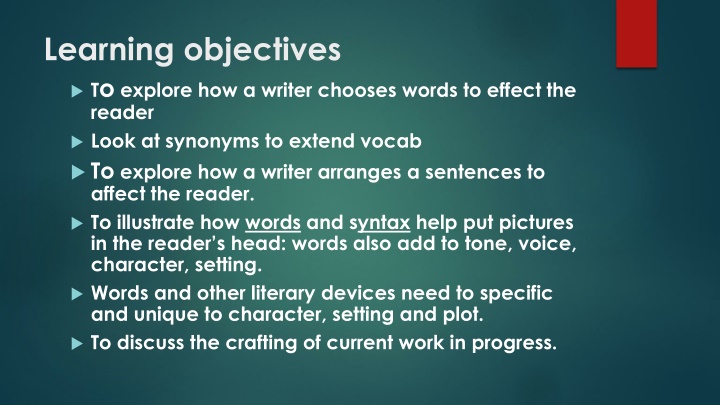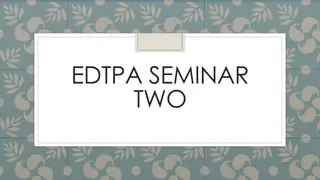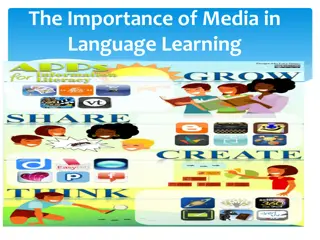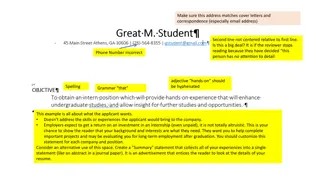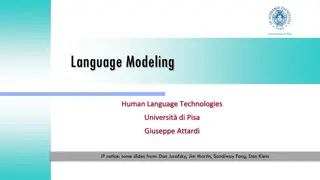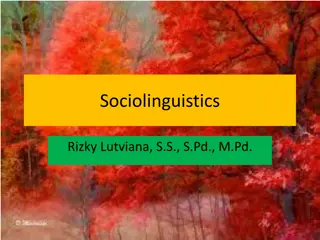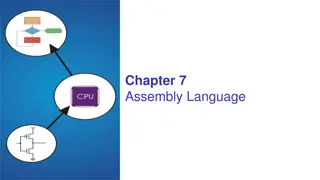Crafting Language for Impact
Delve into the art of word choice, sentence arrangement, and descriptive writing to create vivid imagery, evoke emotions, and engage readers. Explore synonyms, show vs. tell techniques, and specificity in writing to enhance your storytelling skills.
Download Presentation

Please find below an Image/Link to download the presentation.
The content on the website is provided AS IS for your information and personal use only. It may not be sold, licensed, or shared on other websites without obtaining consent from the author.If you encounter any issues during the download, it is possible that the publisher has removed the file from their server.
You are allowed to download the files provided on this website for personal or commercial use, subject to the condition that they are used lawfully. All files are the property of their respective owners.
The content on the website is provided AS IS for your information and personal use only. It may not be sold, licensed, or shared on other websites without obtaining consent from the author.
E N D
Presentation Transcript
Learning objectives To explore how a writer chooses words to effect the reader Look at synonyms to extend vocab To explore how a writer arranges a sentences to affect the reader. To illustrate how words and syntax help put pictures in the reader s head: words also add to tone, voice, character, setting. Words and other literary devices need to specific and unique to character, setting and plot. To discuss the crafting of current work in progress.
Five tips on showing not telling Try to remember some of the important rules of Show don t Tell 1. Use strong verbs when describing action: 2. Try to appeal to all five of the senses 3. Choose specific events to describe a long-standing situation 4. Describe reactions rather than standalone emotions 5. Be specific with dialogue
Have a pallet of word. Find synonyms for all these words Happy Sad Angry Excited Giddy Love Anxious Joy Disgust
Showing vs Telling Warm up exercise: Convert the following telling narration into showing , i.e. into dramatization with concrete spoken dialogue as opposed to summary. Add more details (sounds, etc), use speech marks, indents and keep it in the PAST TENSE: think about senses, reaction, strong verbs She answered the phone and gave her name. She said she did not take cold calls and that she regarded them as an invasion of privacy. She added that she was especially not interested in double-glazing.
Specificity Descriptive writing, or the art of painting a picture in your reader's mind, is one of the most powerful techniques to master, whether you are writing fiction or nonfiction. The key to making it work and to making your prose more powerful is specificity.
Specific Words Usually when people read nonfiction story, they want to know they are getting as close as possible to a firsthand account of events that really occurred. They want to feel as though they are hearing the story from someone who was there, and a genuine eyewitness can give specific details of what happened. Although people know fiction is, well, fictional, good fiction should nonetheless have the have the ring of authenticity to it. Again, the way you convey that authenticity is by descriptive writing that includes specific details someone who was actually present would know. So what could we do with our vague first sentence?
A guy walks into a bar and orders a drink. Now, this may paint a picture in a reader's mind, but it's pretty generic. It could be any guy, in any city (and any drink). A sentence this vague tells you right away this is going to be a make-believe story, not something that really happened. It would be a weak start to a nonfiction account or a novel. Have a go at making this more specific. Think about the words you can change and why you do this. Think strong verbs and specific nouns.
adding more information One approach might be to continue our descriptive writing, adding more information as we go: A guy walks into a bar and orders a drink. He was old and tired, and he wanted to escape his loneliness for one night by getting very drunk. How many of you did this? Now this is slightly better, but not much. It tells us a little bit about the character and his intent, but as descriptive writing goes it is still pretty generic. Also, it breaks an important principle of good writing: show, don't tell. This second sentence tells us what the character wants, whereas it's usually better to show the reader a specific detail and let the reader infer the character's desire.
So let's try a different tactic Let's go back to the first sentence and replace some of the more generic words with more specific ones: A grizzled prospector stumbled into the dark saloon and demanded a bottle of whiskey. Now this is better. It is no longer a generic bar in a generic setting. We can infer it is a bar in the old West. The character is not just any guy, but a type of character typically found in Westerns. The verbs stumbled and demanded convey more about his personality and the condition of his body, as does the adjective grizzled.
Be Specific The type of drink he orders and the quantity reveals something about his state of mind and his tastes. What's more, it does so by showing, rather than telling. In fact, we may not need the second sentence now, because we can infer the prospector's reason for ordering the whiskey. People usually don't stumble into a place if they are expecting to meet someone. And only someone who is lonely and/or miserable would order an entire bottle of whiskey for himself.
Specificity A guy walks into a bar and orders a drink. A woman ran down the road. Three men sat on a train and read a newspaper She heard footsteps creeping behind her and it made the whole situation scarier. Make these better sentences with more specificity. Characterisation, intent, POV, setting, strong verbs that indicate characterisation: why are they there? Who are they meeting if anyone, psychological state, physical attributes . Draw the reader into the world of the story by being there for them. Now add more specific detail to see what kind of story might emerge. Remember: Show Don t Tell.
Five tips on showing not telling What do you remember about the rule Show don t Tell to give as tips to writers? 1. Use strong verbs when describing action: 2. Try to appeal to all five of the senses 3. Choose specific events to describe a long-standing situation 4. Describe reactions rather than standalone emotions 5. Be specific with dialogue
1. Use strong verbs when describing action You may have been told in the past to eliminate all adverbs. This might sound excessive (and adverb s are sometimes useful), but the main reason for this advice is that a lot of the work of an adverb can be done by a better verb. Often adverbs indicate weak verb choices. Compare these sentences: She walked slowly across the room. She crept across the room. She shuffled across the room. Notice how dull and lacking in vivid imagery the first one is compared to the next two. Items two and three give us a much more visual sense of how she walked slowly across the room.
2 .Try to appeal to all five of the senses Keep in mind that it s important to choose the right details. Being specific doesn t mean describing every single thing. Pick the particular things that are most important for giving your reader a sense of the scene and the mood and atmosphere you want to set up.
3. Choose specific events to describe a long-standing situation Perhaps you have a protagonist who is traumatized from witnessing violent fights between her parents when she was young. Rather than say that they yelled at one another a lot or one parent physically abused the other, describe one particularly harrowing memory. One concrete event will give the reader a much better insight into what the character is dealing with.
4. Describe reactions rather than standalone emotions Describing the reactions of a character to a situation is better than simply naming the emotion or sensation the character is feeling. Take a look at the difference in the pairs of sentences below: She was cold. The wind sliced through her jacket, and her shoulders ached from hunching against its icy blast. He felt worried. His stomach was clenched with anxiety, and he couldn t finish his sandwich. Do you see how in both cases, the second sentence shows instead of tells and thus gives us more specificity and a stronger mental image of the situation?
5. Be specific with dialogue Think about how old your characters are and where they are from. Whether or not your characters speak in a dialect, they should speak in a way that is appropriate for them so that their voices are not non-descript and interchangeable make then unique and extraordinary.
Showing vs Telling RETURN TO THE FIRST WARM UP EXERCISE: Can you improve it and can you see what you did and are doing to make it SHOW and not TELL (refer to techniques on these slides and in your notes? Convert the following telling narration into showing , i.e. into dramatization with concrete spoken dialogue as opposed to summary. Add more details (sounds, etc), use speech marks and keep it in the PAST TENSE: think about senses, reaction, strong verbs etc. She answered the phone and gave her name. She said she did not take cold calls and that she regarded them as an invasion of privacy. She added that she was especially not interested in double-glazing.
Exercise: Develop these from telling to Showing Tell: She was my best friend. I could tell her almost anything. Show me the impact these two characters have on each other. Tell: I was so excited. Show me what excited looks like to you and your characters Steve was frustrated. Show me how he was frustrated By using these simple emotions try and find stronger verbs, more descriptive and colourful and action packed ways of SHOWING me: Happy/ Sad/ Angry/Excited/Giddy/Love/Anxious/ Joy/Disgust
Crafting your existing writing: developing your work further Find a piece you have written and would like to develop further. Using today s skills and techniques re-craft and edit the work so you are using specificity and show and not tell Tell me the decisions and choices you have made, especially word choice: strong verbs and specific nouns What else have you developed and what decisions have you made?
Crafting your existing writing: developing your work further Read through your writing and circle every telling word/sentence you can find. Anything that explains one of the 5 senses. Then write down specifics for each. If you heard someone creeping up behind you, how did you hear it? Was it crunching on gravel? Was it the shuffling of shoes against carpet? Skim through your writing and circle every word that s an emotion. Then, for every emotion-explaining word you find, write down physical reactions of feeling that way.
